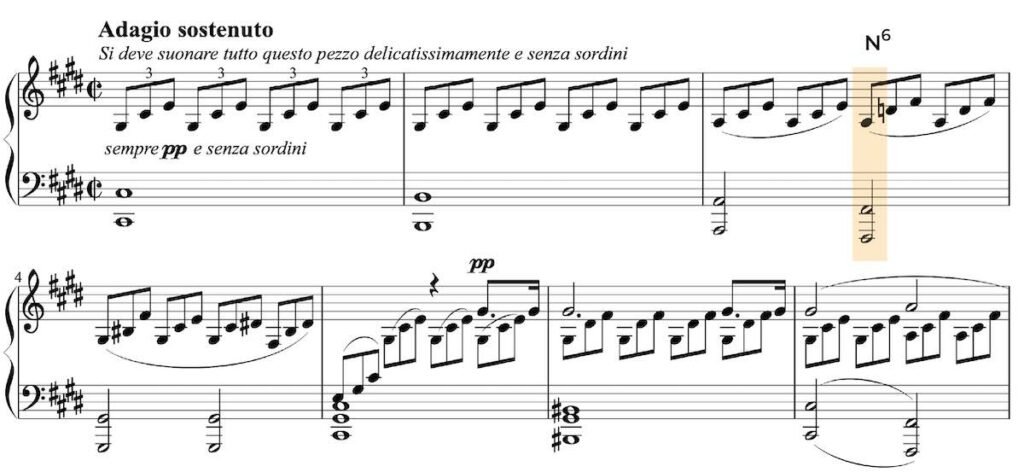The Neapolitan chord is a very unique chord. It is extremely interesting as it is non-diatonic, simply meaning it is not built from notes in a major or minor scale. The Neapolitan chord is a chromatic chord and can give a particularly dramatic effect.
What Are Neapolitan Chords in Music Theory?
The Neapolitan chord is a major triad built from the flattened (lowered) second scale degree. The scale degrees that a Neapolitan chord is made up of are the flattened 2nd, 4th and flattened 6th. When we say flattened we don’t mean that the note will literally have a flat sign written on it, it just means lowered by a semitone (half step).
Neapolitan chords are most often seen in a minor key because the sixth scale degree has already been lowered, meaning only the second scale degree needs to be changed. In a major key both the 2nd and 6th scale degree would need to be lowered.
A neapolitan chord is sometimes called a Phrygian ii chord because in minor scales, the chord is built on the notes of the corresponding Phrygian minor mode.
If we take the key of A minor, the second note is B. If we lower the B by a half step we arrive at the note Bb. A Neapolitan chord in A minor is a Bb major chord!

If we take the key of E minor, the second note is F#. If we lower the F# by a half step we arrive at the note F. A Neapolitan chord in E minor therefore is the same as an F major chord.

The First Inversion
What we have written above is a Neapolitan chord in root position. However, neapolitan chords are most commonly written in first inversion.
First inversion simply takes the root note up an octave, leaving the second note of the chord at the bottom. The Neapolitan chord in E minor in first inversion would therefore have the notes A C F.

In figured bass, a first inversion chord is simply labelled with the number 6. This is why you will sometimes see a Neapolitan chord referred to as a Neapolitan sixth chord.
Alternative way of thinking about the neapolitan chord
The neapolitan chord is sometimes thought as coming from a subdominant (iv) chord. This iv chord would then have the fifth of the chord replaced by a chromatic upper note, creating a first inversion Neapolitan sixth chord.
In F# minor, iv chord (subdominant triad) has the notes B, D, F#. If the F# is raised by a semitone to a G natural, we have created a first inversion G major chord.

How is a Neapolitan chord labelled?
The most common way to create a neapolitan chord is from the ii chord and so this is the labelling we will look at.
We label a Neapolitan chord with either:
bII6 – Literally flattened second and the 6 meaning first inversion
OR
N6 – N referring to neapolitan chord and the 6 meaning first inversion

Harmonic Function of a Neapolitan Chord
Very much how chord ii is often used as a pre dominant chord, the n chord or Neapolitan chord is used in the same way. This flattened ii chord (n chord) will set up a dominant chord which will then resolve to the tonic.
Below we have an example in E major. We go from the Pre dominant chord (N6), to the dominant chord (B major chord), to the tonic chord (E major chord).

However, you will most often see Neapolitan chords in minor keys. Take a look at the example below in A minor.
We go from the pre dominant chord (N6), to the dominant chord (E minor chord), to the tonic chord (A minor chord).

We most usually see a Neapolitan chord in a minor key, because the sixth scale degree (vi) is lowered and therefore is the same note that would appear as the 5th in a Neapolitan chord.
Ear Training and Chords
To develop as a musician you’ll want to be able to recognise chords by ear. This is where ear training comes in. My recommendation for this is Tonegym as they have a comprehensive and fun program for training your ears! It’s what has gotten the best results with for my own students.
In the ‘tools’ section of their site, Tonegym even have a chord player that allows you to listen virtually any chord.
For an in-depth look at ear training, here’s my full review of Tonegym.

How the Neapolitan chord sounds
The Neapolitan chord is considered a chromatic chord but this does not actually mean the chord itself. As we have seen, the Neapolitan chord itself is simply just a major triad.
It is the Neapolitan chords half-step root relationship to the tonic, the diminished third interval created as it resolves and the tritone root movement to its chord of resolution (chord V).
The relationship between each of these chords is what makes the Neapolitan chord chromatic.
Using the Neapolitan chord
When using a Neapolitan chord in our music there are a few important rules that must be followed.
- The neapolitan chord is most usually in first inversion
- Make sure to double the third as it is a primary tone not an altered tone
- Flattened 2nd scale degree must be put in one of the upper parts (alto or soprano part)
- When resolving a neapolitan chord, make sure the lowered second scale degree moves to the leading tone, which is a diminished third below.
Examples of Neapolitan Chords
There are many examples of Neapolitan chords in music. A particular famous example is the 3rd bar in Ludwig van Beethoven – Piano Sonata Op.27 No.2 ‘Moonlight sonata’.

Where does the name ‘neapolitan chord’ come from?
The name neapolitan chord links to a group of composers from Naples, Italy in the 18th century. This group of composers were called the neapolitan school . Some examples of composers from this school are Scarlatti and Pergolesi.
What’s Next…?
- Learn about chords with our complete guide to chord.
- Learn about a fundamental type of chord, the seventh chord.
